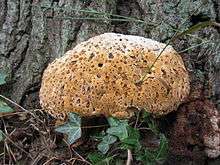Inonotus dryadeus
Inonotus dryadeus, commonly known as oak bracket, warted oak polypore, weeping polypore or weeping conk, is an inedible species of fungus belonging to the genus Inonotus, which consists of bracket fungi with fibrous flesh. Most often found growing at the base of oak trees, it causes white rot and decay of the trunks. It secretes an amber liquid which weeps from tubes in its upper surface.
| Inonotus dryadeus | |
|---|---|
 | |
| Inonotus dryadeus on an oak tree | |
| Scientific classification | |
| Kingdom: | |
| Division: | |
| Class: | |
| Order: | |
| Family: | |
| Genus: | |
| Species: | I. dryadeus |
| Binomial name | |
| Inonotus dryadeus | |
| Synonyms | |
Description
The thick fruiting body of Inonotus dryadeus varies in size from 5 cm to 30 cm in width,[2] although specimens up to 75 cm have been found.[3] Its velvety upper surface is cream to rusty brown with a yellower margin, and is pitted with tubes up to 3 cm deep which ooze an orange-brown liquid when the fruit body is young,[1][4] hence the name "weeping conk".[3]
On the buff underside there are 4–6 fine pores per millimetre. These are initially greyish-white but mature to yellow or ochre.[5]
The flesh is soft and fibrous, yellow-brown in colour and has an unpleasant odour.[4]
Similar species
I. cuticularis grows on beech, sycamore and elm.
Habitat and distribution
Inonotus dryadeus is a parasitic saprobic fungus,[1] with spores entering wounds on broadleaf trees (predominantly oak, although sometimes maple, elm and chestnut).[4] It grows close to the ground on the trunk, thickly attached, and either singly or in groups.
It has been observed in North America and temperate northern Europe, where it is described as widespread but locally common.[4] Fruiting occurs in summer and autumn, but fruit bodies may overwinter and persist for several years, eventually turning black and cracked. Presence of a fruit body may indicate that the mycelium has penetrated and weakened the root crown of the tree.[3]
References
- Gary Emberger (2008). "Inonotus dryadeus". Messiah College. Retrieved 30 July 2010.
- Pegler, David (2001) [1990]. Mushrooms & Toadstools of Britain and Europe. Kingfisher field guides. Kingfisher Books Ltd. p. 155. ISBN 978-0-86272-565-5.
- Swiecki, Tedmund; Bernhardt, Elizabeth (July 2006). "A Field Guide to Insects and Diseases of California Oaks" (PDF). United States Department of Agriculture. Retrieved 30 July 2010.
- Evans, Shelley; Kibby, Geoffrey (June 2004). Fungi. Pocket Nature. Dorling Kindersley. p. 226. ISBN 978-0-7513-3696-2.
- Sterry, Paul; Hughes, Barry (September 2009). British Mushrooms & Toadstools. Collins Complete Guides. Collins. p. 286. ISBN 978-0-00-723224-6.